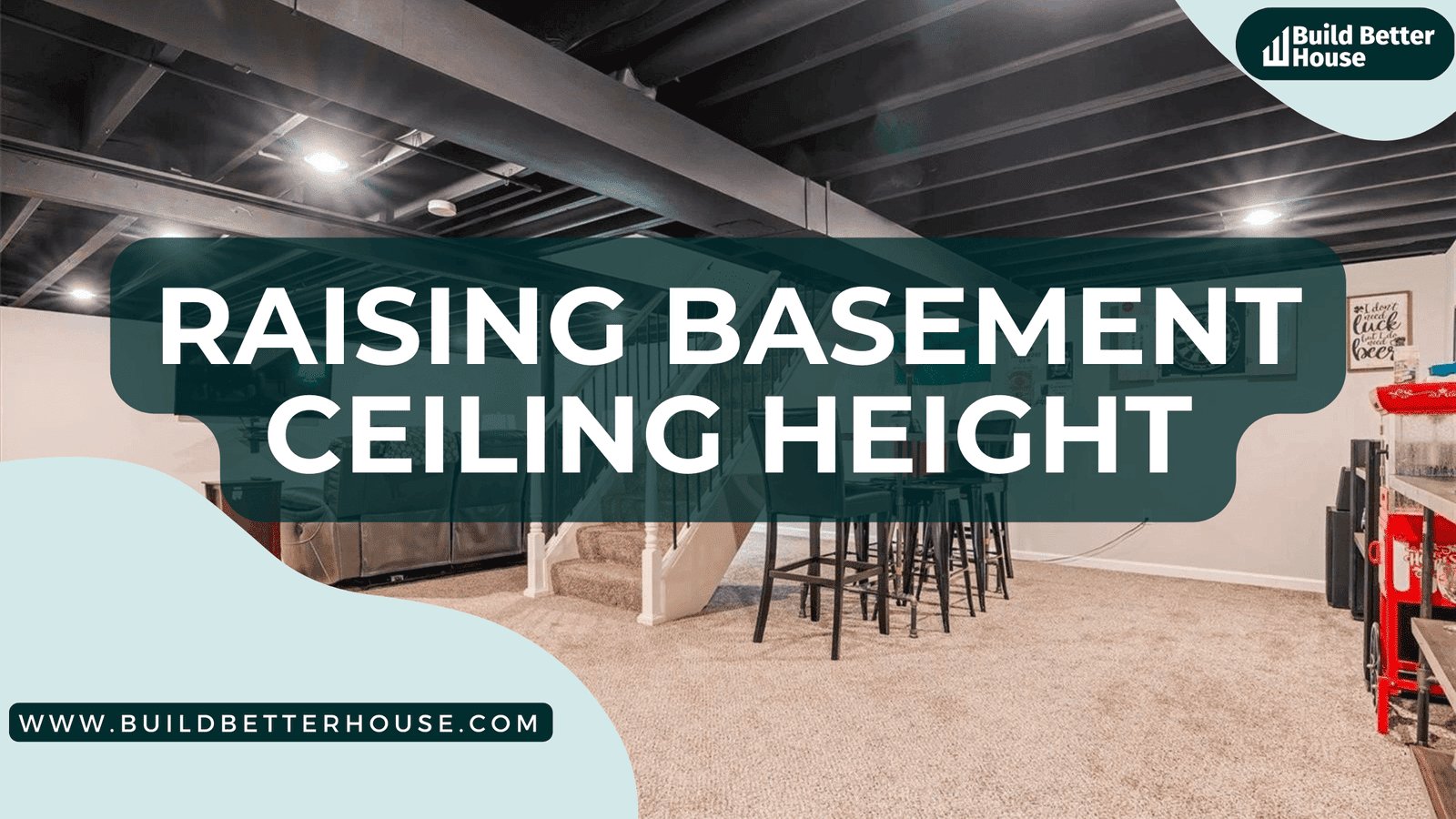Raising Basement Ceiling Height: What You Need to Know 2023

Do you want to make the most of your basement space by raising the basement ceiling height to create a more comfortable living space? Don’t worry; it’s pretty simple! This article will show you all the critical factors to consider before raising the basement ceiling height.
FAQs
1. What is the best way to finish a basement ceiling?
The best way to finish a basement ceiling is by installing drywall, adding acoustic insulation, and then painting or staining the drywall. If the basement has existing panels, it is important to check for any water damage and replace any damaged panels with new ones before painting or staining them.
2. Can you leave a basement ceiling exposed?
Yes, you can leave a basement ceiling exposed, provided it is structurally sound. If not, additional supports may be needed to expose the ceiling safely.
3. Does basement ceiling height affect ventilation?
Yes, basement ceiling height can affect ventilation. A higher ceiling may lead to increased air circulation, while a lower ceiling may impede airflow, reducing ventilation in the space.
4. What is the importance of basement ceiling heights?
Basement ceiling heights are important because they determine the available space and can impact a home’s energy efficiency. Additionally, basement ceilings need to be high enough to accommodate.
What is the standard basement ceiling height?
The average basement ceiling heights generally range from 7 feet to 8 feet. While most ceilings are 7 feet or higher, some basements may have lower ceilings, as low as 6 feet. Knowing this before a project is vital because it will determine what fixtures and materials can be used in the basement.
Additionally, the height of the ceiling may limit certain activities you can do in the area, depending on your size. It’s always best to measure the exact height of your basement’s ceiling before starting a project to ensure you are prepared for any limitations.
Basement ceiling height requirements
Generally, the minimum ceiling height requirement for a habitable room in most jurisdictions is seven feet. This applies even if you use the basement as a bedroom, family room, recreational space, workshop, or studio.
In some jurisdictions, conventional basements can drop below seven feet in certain areas, but this usually requires engineered trusses and other framing expertise.
Fire separation requirements
For any non-habitable rooms like storage spaces or utility closets, local basement ceiling height requirements are typically lower due to fire separation requirements from habitable rooms.
Depending on the jurisdiction, fire separation can also dictate a minimum required basement ceiling height of 5 ½ – 7½ feet depending on occupancy type and if sprinklers are installed.
Structural limitations
Of course, your finished basement ceiling cannot exceed whatever structure is holding it up above; therefore, it’s important to note whether there are any permanent beams or existing HVAC systems restricting headroom before beginning renovation work in your basement.
If necessary, you may be able to borrow volume from another area without compromising structural integrity, but this should be done by an engineer specializing in foundations and framing since excessive load-bearing needs to be considered in these situations.
If renovating a living space within the basement guidelines, additional features may need planning consideration, such as electrical wiring for lights or built-in fixtures for windows and doors.
During construction planning phases, all requirements must be carefully reviewed with experts so that acceptable habitation standards are met with safety for everyone in mind – rethinking elements such as smoke detectors placement and width of egress doorways.
Minimum basement ceiling height requirements
The authoritative International Residential Building Code (IRC) states that basements must have at least one room with a minimum floor-to-ceiling height of seven feet and all other habitable rooms with a minimum floor-to-ceiling height of six feet eight inches.
Inhabitable areas like crawlspaces only require five feet five inches of clear ceiling space. At the same time, goals and stairways could be slightly lower but remain immune from any obstructions in an emergency.
Furthermore, the headroom clearance required will differ according to local building codes and regulations in your area, which should be consulted before proceeding to ensure that your project meets all the applicable legal standards.
It may also depend on whether you plan on finishing the area or leaving it unfinished – different specifications may apply accordingly.
Additional considerations
It’s also important to consider that finished basements usually need more ceiling clearance than those left unfinished. This is due to additional headroom required for HVAC ducts, insulation systems, electrical wiring, and fixtures like light fixtures or ventilation fans. This can further reduce the available headroom in otherwise habitable spaces.
Unfortunately, if you plan on finishing your basement, follow build code rules related to construction distance from fire alarms/detectors and sprinklers by lowering objects such as pipes or elevating them where necessary before starting work.
Finally, when deciding how high to make your basement ceilings, remember that taller heights allow for better airflow and allow you to install taller furniture pieces should you decide to turn the space into a bedroom, which will significantly optimize its design potential without compromising habitability standards altogether.
Existing buildings
Basement spaces in existing homes must have a maximum basement ceiling height of 6 feet 4 inches and allow for girders, ducts, beams, pipes, and other architectural impediments.
Bathrooms in old-built homes must have a standing height of 6 feet 4 inches for flush toilets, bidets, and sinks. A showerhead must also be 6 feet 4 inches tall above a 30-inch X 30-inch space and perform properly.
Sloped ceilings and soffits, on the other hand, are permitted as long as they do not interfere with plumbing fittings.
Description
- The clearance height is 6 feet 4 inches for existing basement buildings, including obstructions.
- Sloped space exceptions
Clearances for stairways
Existing stairways must have a headroom clearance of 6 feet 8 inches across the whole path, measured vertically from the slope on the tread nose, the surface of a landing, a platform, or the floor. This is vital to consider in locations where a slanted ceiling is required.
Similar tutorials
Do you want to know how to heat a basement? We have devised This simple ‘how to heat a basement’ tutorial provides five various strategies you may use to ensure a warm and comfy basement throughout the chilly winter months.
Struggling with how to ventilate a basement? Find out how to ventilate a basement in seven simple steps – this ultimate guide covers you!
Looking for the best basement carpet to complete your cozy home’s décor? Today, we’ve brought this blog post; Check out our top three best basement carpets and learn how to pick the best one for you!
Summing up
Generally, the appropriate basement ceiling height is determined by some criteria,
including the type and purpose of your basement and design considerations. Most building rules, however, demand at least 7 feet of unfinished basement ceiling height from the floor to the joists, with some codes requiring 8 feet in sections classified as living quarters.
Check with your local building codes for specific requirements in your area. Before determining a new basement ceiling height that matches your needs, you must consider any ducting, pipes, or other utilities that may affect your basement’s headroom.
If you found this post helpful, leave your feedback in the comments box below, and please share it with your friends and family.
Read more:
How Long Does A Sump Pump Battery Last? Here’s The Truth
Can I Unplug Sump Pump? 4 Easy Tips You Can Try
Plumbing Fixture Calculator: How To Measure Correctly?
Sump Pump Replacement Cost: How To Get The Best Price?






